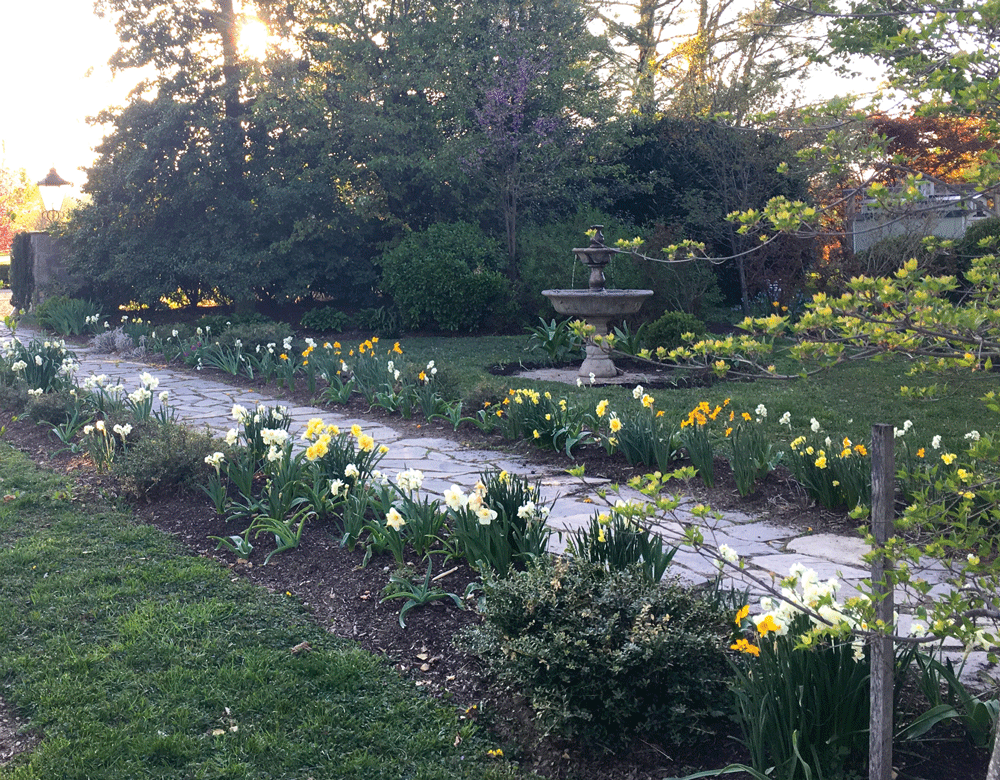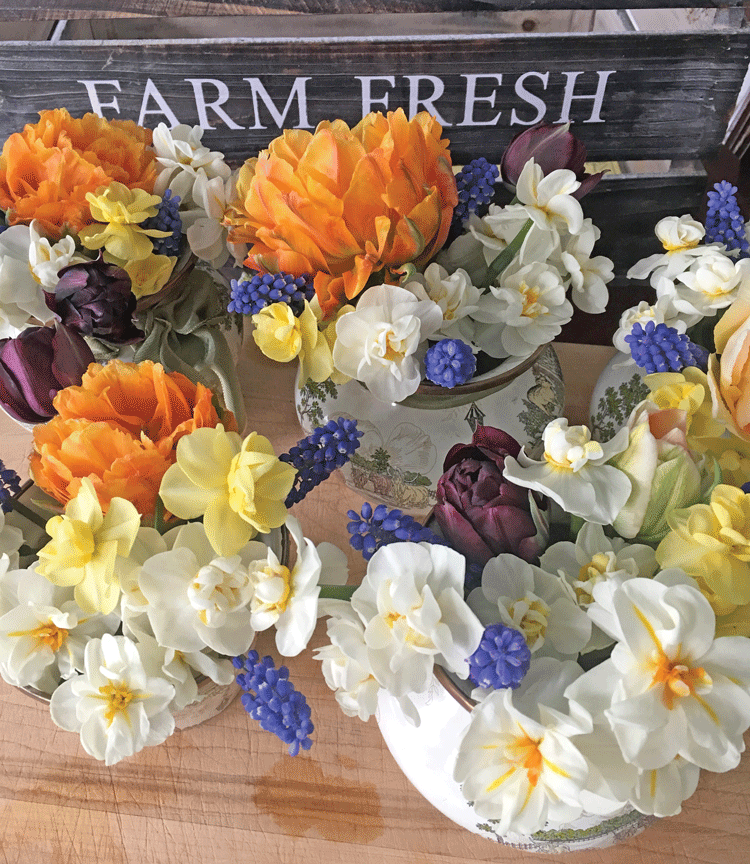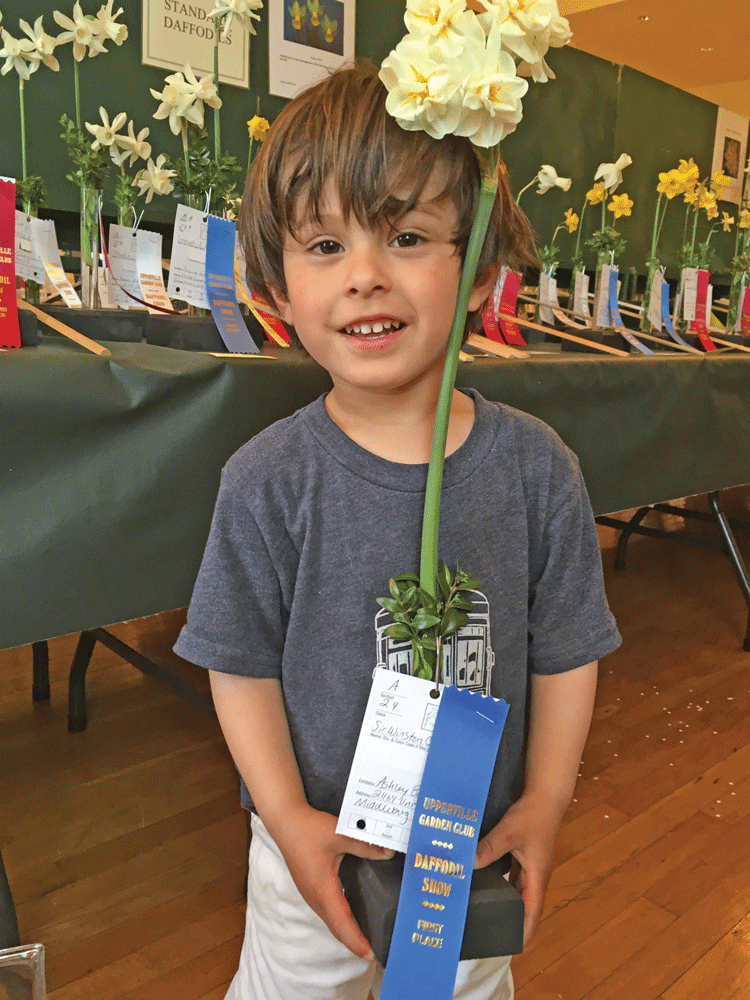Daffodil Love

By Ashley Bommer Singh
Just as my early daffodils started to bloom, we had another snowstorm. The only thing I could do was run out in snow boots and cut. My son’s birthday party featured parsley and ranunculus in clay pots and these early-blooming, two-tone yellow Carlton daffodils in vases.
The Carltons peak too soon for the Upperville Daffodil Show in early April. I love the show—so many participants, so passionate about the daffodil. I remember walking in with my first entrant a few years ago and someone calling out, “We have a Winston Churchill!” when they spotted mine. Only a Narcissus aficionado would be able to spot a daffodil from across the room and call out its cultivar. I’ve ordered Sir Winston Churchill bulbs every year since.

The Narcissus genus is named for the Greek god who was so lovely in every way that the prophet of Thebes warned he must never see his own beauty. According to Ovid, Narcissus rejected the love of the nymph Echo, who wasted away in despair until only her faint voice remained. He then went to drink from the fountain and fell in love with his own reflection. Unable to look away, Narcissus stayed rapt until he died, and in that very spot, up came the daffodil.
Daffodil shows bring passion. There are techniques to polish petals and encourage prolific blooms. Q-Tips are used to clean and smooth; spray bottles with special water and fans are all part of the competition. My neighbor once sent me a small, tall cooler, worried that my daffodils were blooming too soon. Alas, I still rely on picking early that morning and hoping for the best.
My friend Cynthia Morris and her neighbor Linda Corley shared daffodil bulbs every year. Linda had the experience of a lifetime after retiring as a longtime teacher at Loudoun Country Day. She was asked to plant and tend 100 daffodil varietals in Berryville every year for the late Sarah Burton, onetime President of the Virginia Daffodil Society and American Daffodil Society judge.

Linda (and her husband Don) was under Mrs. Burton’s watchful eye and strict planting instructions: 12-inch holes, a pinch of mulch and sand, and special method of twisting the bulb one-quarter turn before covering. Linda documented each daffodil on a clipboard. They would cleverly weave Virginia bluebells throughout to extend the bloom through May and ended long days of planting with a glass of sherry. Linda fondly recalled hand-picking leaves off the daffodil stems in Mrs. Burton’s nursery for daffodil shows like Upperville. When Linda reported seeing some cutthroat competition like stems being subtly bent, Mrs. Burton simply said, “Linda, what did you expect?”
Of course, you don’t have to enter shows or follow strict planting protocols to lavish in daffodils. For such beauties, they are the most unfussy bulb you can plant. They are deer and pest proof. They naturalize and spread. They require a hole three times the size of the bulb and adore a little mulch. The bulbs are self-contained nutrient power houses, only requiring that they not be disturbed, including after they bloom. So if you cannot stand the yellowing leaves as your daffodils fade, tie them down or plant around them (Mrs. Burton’s method). Hold the weed whacker.
Early settlers in Virginia planted golden daffodils as mementos of spring back home. They shared them neighbor to neighbor, and in the coastal climate, daffodils quickly spread from homes to the fields. If you drive down to Gloucester, Virginia, countless daffodils line roads, crags and crannies, and the shoreline. This town became the daffodil capital of America in the 1930s after production ramped up following a worm infestation of bulbs in Holland. Farmers in Virginia, including Charles Heath, were tapped to grow them in their sandy soil. Brent and Becky’s in Gloucester (where I get my daffodil bulbs) is still run by the Heath family.
While many bulbs fade with time, daffodils survive and thrive. The ones you plant today will probably outlast you and be around for generations to enjoy. According to the Royal Horticultural Society, there are some 26,000 daffodil cultivars, or hybrids, categorized among 13 divisions including trumpet, large cup, poeticus, jonquilla, and miniature.
Horticulturalists create new daffodils every year. Historical varieties I come back to again and again include Barrett Browning (1945) with large orange cups and white petals; Thalia (1916) with all white petals and centers; and Lucifer (1897) with angular petals that look like stars. The first spring we moved here, I was excited to find Actaea (1919), or Poet’s daffodil, on our farm tucked near large boxwoods. They might have been here back when the farm was still the local schoolhouse.
My favorite new varietals include the Sir Winston Churchill with small clusters of three to five white flowers with saffron hearts; Pappy George with its flame orange centers and sun yellow petals and British Gamble with its pale salmon cups and white fluttering heads. For scent, I also love Bridal Crown with its creamy peony-like flowers and Sweet Pomponette with its lemon and vanilla ruffles. Looking at my list now, with its random color pairings, I have to laugh. Gardening is definitely learning what you love by trial and error, and not always planned.
I like daffodils in borders, near my apple trees and spread at random. In borders their leaves will soon be overtaken by other perennials, and as long as they have some sun, they will be fine. To get that random, wild look, throw bulbs down as you walk, and plant where they fall. Or you can get ambitious and plant daffodil rivers, featuring thousands of bulbs, planted in drifts of different colors. This may evoke the crowd of daffodils British poet William Wordsworth saw in 1802 on a walk with his sister Dorothy in the Lake District of England. Those dancing blooms inspired his most famous poem, “I Wander’d Lonely As A Cloud.”

When my daffodils return like old friends, especially after a hard winter, I start to imagine lunches served in the garden. I may not get to planting thousands of daffodils like Linda and Mrs. Burton, but one can dream. ML
I wander’d lonely as a cloud
That floats on high o’er vales and hills,
When all at once I saw a crowd,
A host of golden daffodils,
Beside the lake, beneath the trees
Fluttering and dancing in the breeze.
Continuous as the stars that shine
And twinkle on the milky way,
They stretch’d in never-ending line
Along the margin of a bay:
Ten thousand saw I at a glance
Tossing their heads in sprightly dance.
The waves beside them danced, but they
Out-did the sparkling waves in glee: –
A poet could not but be gay
In such a jocund company!
I gazed – and gazed – but little thought
What wealth the show to me had
brought.
For oft, when on my couch I lie
In vacant or in pensive mood,
They flash upon that inward eye
Which is the bliss of solitude;
And then my heart with pleasure fills
And dances with the daffodils.
William Wordsworth


